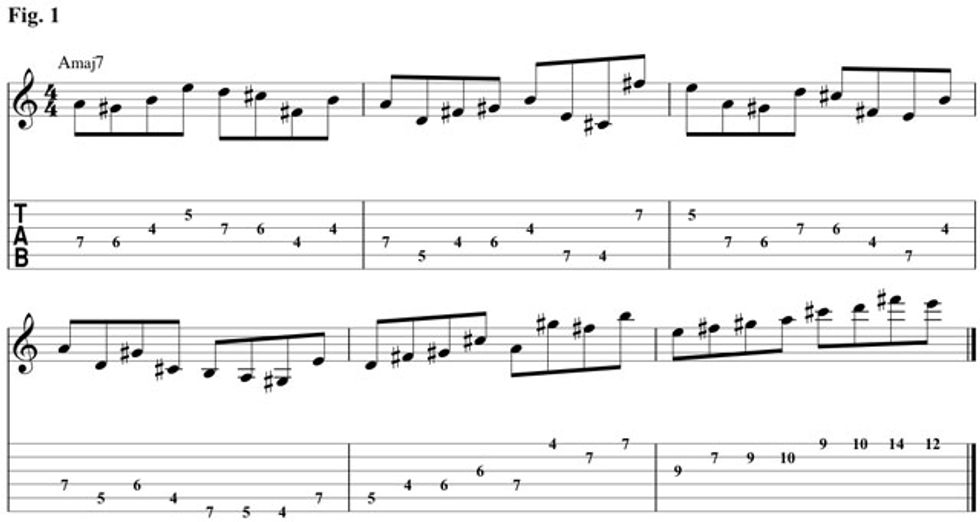Chops: Intermediate
Theory: Beginner
Lesson Overview:
• Create flowing lines that
include intervallic ideas.
• Incorporate different rhythmic
devices into your improvisations.
• Outline chord changes clearly
with a series of eighth-notes.
I’ll never forget first hearing Pat Metheny’s solo break on “Third Wind.” After about a minute and a half of developing an actively growing harmonic progression with incredible rhythmic intensity, the whole band comes to a complete stop and Pat plays an eight-measure break filled with big intervallic leaps, slurs, dynamic changes, and colorful harmonic implications—all in the blink of an eye. Before you know it, the band is back in and his solo is officially under way. Pat’s ability to take an eight-measure phrase of 16th-notes and bend them like a rope around a curving path blew my mind.
And the deeper I got into the master improvisers—like John Coltrane, Bill Evans, Sonny Rollins, and John McLaughlin—the more I heard this approach being repeated, each time with unique and stunning variations. So today I want to explore ways to approach improvising long, fluid, rhythmically dynamic lines.
A great way to begin this process of discovery is to start within a given scale or tonal center. For this exercise, we’ll use the key of A major. Often when we practice scales, we’ll start from the lowest note and move in sequence up to the top and then back down. The drawback to this approach is that we unconsciously condition ourselves to improvise in the same way. This is why your soloing can start to sound like you are running a series of scales rather than creating musical phrases with a clear narrative.
To counteract this tendency, let’s try a different approach. First, set the metronome to a comfortable tempo for eighth-notes—perhaps a quarter-note at about 66 bpm. Next, designate a time frame (five minutes, for example), and then begin improvising within the A major scale, but using random sequences of notes.
In addition to the tempo and tonal parameters that are in place, include in your awareness the physical parameters of the guitar. By making all seven notes of the A major scale fair game, you begin to break down preconceived ideas of positions. You can see an example of this in Fig. 1. Although I think positions can be of great benefit to a guitarist, I have found tremendous freedom in viewing all As or C#s or F#s as equal. The fingerings presented in these examples are merely a suggestion. I encourage you to explore and find and explore your own fingerings while not becoming locked into one shape. Your hand should be free to move to anyone of them in the spirit of honoring the musical statement you’re making at any given moment.

Once you begin to feel an increased sense of agility and free movement in both hands, shift your focus to playing lines that move entirely in a given direction. One of the attributes that all my favorite improvisers seem to share is the ability to play long fluid lines that move entirely up or down the neck. It seems they are unobstructed by any physical barriers set by the instrument, or at least they’re able to deal with them in a way that is not obvious to the listener.
So let’s practice alternating two measures of a line in A major that goes entirely up—meaning every pitch is at least one step higher than the last—followed by a twomeasure line that moves entirely downward (Fig. 2). This exercise is especially tricky on the guitar, because so often we’ll reach the high string and still have another measure’s worth of notes to play. In this case, the biggest challenge is pacing your line so you move as much horizontally on a given string as you do vertically. This strategy helps you avoid getting stuck on the 1st string in the home stretch.

So far, we’ve kept the rhythmic parameters constant by playing only eighth-notes. Now, it is time to add the eighth-note triplet to the mix. One of the ironies of playing long, impressive-sounding lines is that even if the content is interesting, if the rhythmic delivery is constant (da-da-da-da-da-da) it can be easy for the listener to tune out. So rhythmic variety is essential. Let’s continue alternating lines that go up with lines that go down, but this time we’ll add at least one eighth-note triplet per line. In Fig. 3, you can see an example of an improvisation using this idea.

In addition to keeping your line sounding active and dynamic, this can prove to be a wonderful study for your picking hand. When I first started incorporating triplets into my lines, it got me to start combining alternate picking and sweep picking, to accommodate the shift back and forth between eighth-notes and triplets. As this becomes more comfortable, try creating your own rhythmic patterns. For instance, try accenting every fifth eighth-note or playing four triplets in a row. As you do this, keep moving up the neck and try to incorporate slower subdivisions. Soon, you’ll be able to switch between slower and faster subdivisions with tremendous ease—all while maintaining the melodic integrity of your line.
Finally, let’s apply these lines to a chord progression. When improvising lines over a series of chords that change every measure or two, it can be easy to feel overwhelmed by the harmonic variety and result in your lines sounding choppy. In Fig. 4. we will use the following chord progression: Dm–G7–Bbm–Emaj7–Ebmaj7(#11).

Here’s the most important thing to remember when encountering a harmonic progression like this: The integrity of your line shines above all. If the line has a clear direction, rhythmic variation, and great execution, it will be a knockout.
Let’s try it. With a recording of this chord progression in place, practice playing a line of constant eighth-notes (occasional triplets are allowed) that ascends for the first two chords, followed by a line that descends for the next two chords. Finally, play a line that moves in any or all directions for the last chord. Of course, in performance you might not want to always solo in this style, but it can be a great way to get your hands moving in a new and free way. This approach can make a useful starting point for practicing new scales, new chords, or new harmonic progressions.
 Julian Lage is one of those rare musicians who
feels equally at home in acoustic and jazz circles.
He has been a member of legendary vibraphonist
Gary Burton’s group since 2004, and
also regularly collaborates with pianist Taylor
Eigsti. Lage’s latest album, Gladwell, reflects
his wide-ranging musical interests and talents
by incorporating chamber music, American folk
and bluegrass, Latin and world music, traditional
string-band sounds, and modern jazz. For
more information, visit julianlage.com.
Julian Lage is one of those rare musicians who
feels equally at home in acoustic and jazz circles.
He has been a member of legendary vibraphonist
Gary Burton’s group since 2004, and
also regularly collaborates with pianist Taylor
Eigsti. Lage’s latest album, Gladwell, reflects
his wide-ranging musical interests and talents
by incorporating chamber music, American folk
and bluegrass, Latin and world music, traditional
string-band sounds, and modern jazz. For
more information, visit julianlage.com.














